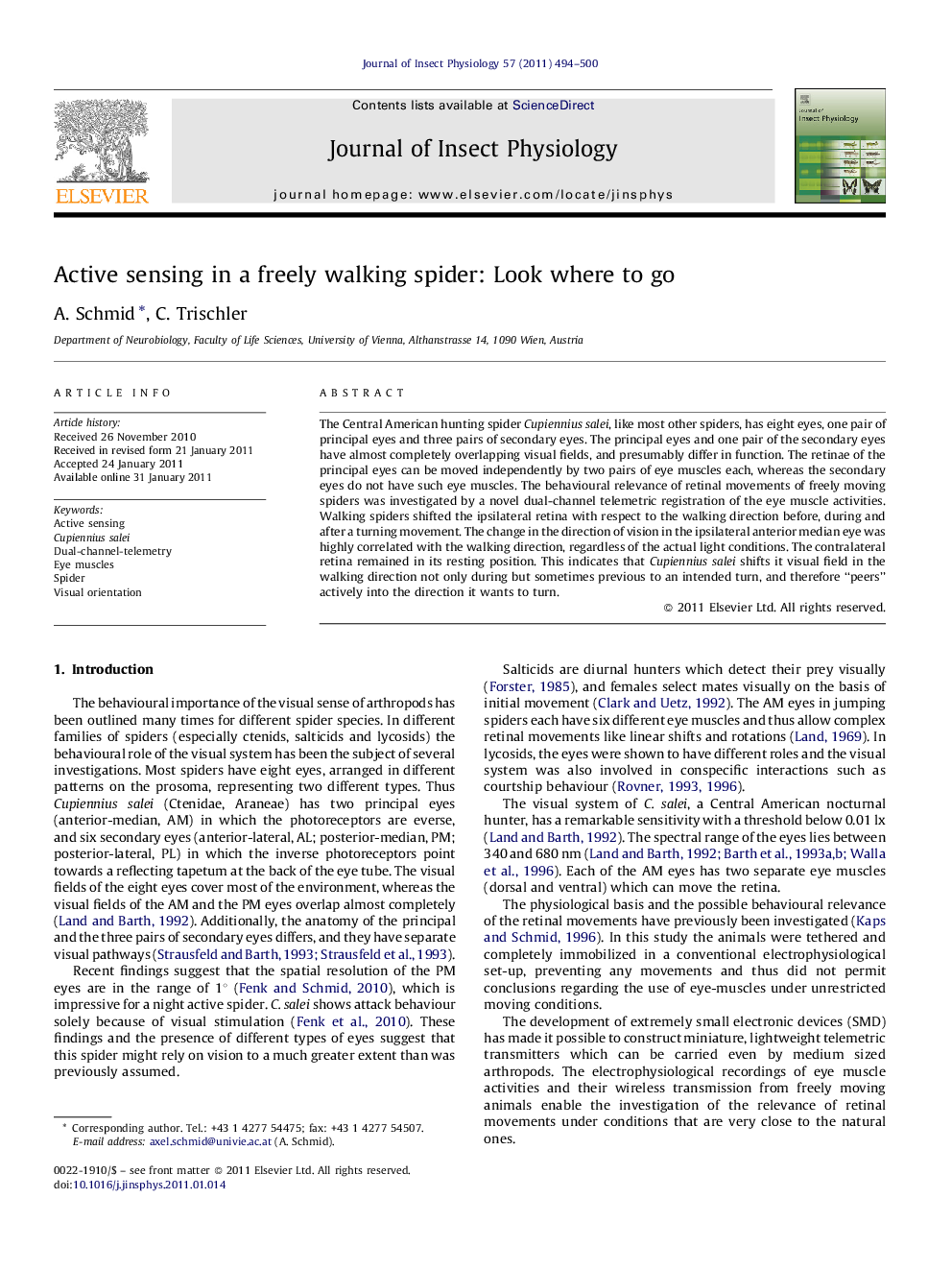| کد مقاله | کد نشریه | سال انتشار | مقاله انگلیسی | نسخه تمام متن |
|---|---|---|---|---|
| 5922252 | 1165360 | 2011 | 7 صفحه PDF | دانلود رایگان |

The Central American hunting spider Cupiennius salei, like most other spiders, has eight eyes, one pair of principal eyes and three pairs of secondary eyes. The principal eyes and one pair of the secondary eyes have almost completely overlapping visual fields, and presumably differ in function. The retinae of the principal eyes can be moved independently by two pairs of eye muscles each, whereas the secondary eyes do not have such eye muscles. The behavioural relevance of retinal movements of freely moving spiders was investigated by a novel dual-channel telemetric registration of the eye muscle activities. Walking spiders shifted the ipsilateral retina with respect to the walking direction before, during and after a turning movement. The change in the direction of vision in the ipsilateral anterior median eye was highly correlated with the walking direction, regardless of the actual light conditions. The contralateral retina remained in its resting position. This indicates that Cupiennius salei shifts it visual field in the walking direction not only during but sometimes previous to an intended turn, and therefore “peers” actively into the direction it wants to turn.
. Circuit diagram of the novel double-channel telemetric device, with all electronic units, as it is connected to the spiders eye muscles. The two L1 units are the sending coils. The entire device is fixed with beeswax on the prosoma of the spider. ME 1 and 2 recording electrodes, RE common reference electrode. (A) Activities of the left (trace 3) and the right (4) dorsal eye muscles and their instantaneous frequencies (1, 2) during a walk (5) under brightness conditions. The visual field of the ipsilateral AM eye is shifted in the direction of the body movement before, during and after the respective movement takes place, whereas in the contralateral eye either no activity or reduced activity is measured. Increased eye muscle activities mostly occur during a turn to the left, as indicated by A (trace 5), and as indicated by C during a turn to the right. The pre-, peri- and post-locomotoric eye muscle activity refer to the turn indicated by A. Between the turns the spider remains motionless indicated by B, and at 7.7 s the animal walks forward indicated by D. (B) Retinal shifts during a walk with more variable body movements, indicated by E are movement to the left, and by F movement to the right, a walk straight ahead is indicated by D. During interruptions of the walk, indicated by B, the motionless animal in general reduces its eye muscle activity. Coding of the different body movement categories (turn left; movement leftwards; movement straight forward; movement rightwards; turn right; no movement) in different voltage amplitudes (2 V; 1 V; 0,3 V; â1 V; â2 V; 0 V) in volt.Research highlights⺠The spider Cupiennius salei moves the visual fields of its principal eyes independently. ⺠The eye muscle activities of both principal eyes were telemetrically recorded. ⺠Only the activity of the eye ipsilateral to the animalÅ turning direction increases. ⺠The animals actively shift their direction of gaze into the intended walking direction.
Journal: Journal of Insect Physiology - Volume 57, Issue 4, April 2011, Pages 494-500